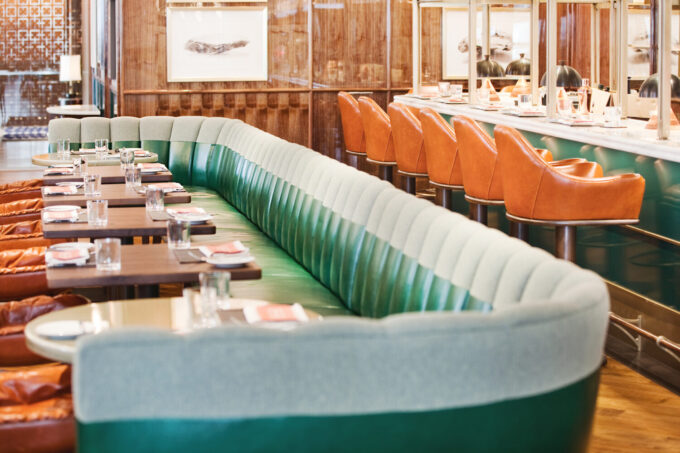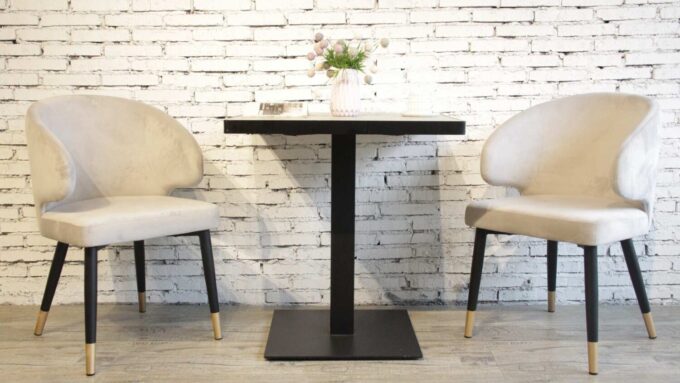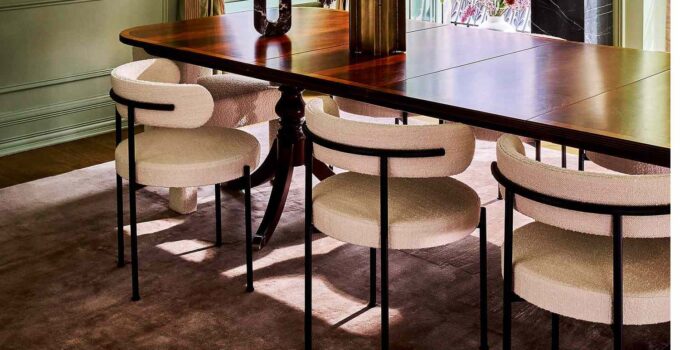The design and choice of furnishings greatly influence the overall atmosphere and patron experience of a restaurant. Among the different components, restaurant chairs are particularly noteworthy since they are both aesthetically pleasing and helpful, and they play a significant role in the establishment’s success. In this in-depth investigation, we go into the world of restaurant chairs, looking at their historical development, ergonomic factors, current design trends, and effects on the dining experience.
HISTORICAL EVOLUTION

Source: louisinteriors.com
The development of dining places is closely linked to the history of restaurant chairs. Back then, simple sitting options like benches and stools were standard in communal dining areas. Restaurant chairs became more sophisticated as society developed. More elaborate and ornamental designs became popular throughout the Renaissance, which was a reflection of the era’s cultural and artistic tendencies.
Restaurant furniture was influenced by a number of design styles that emerged in the 19th and 20th centuries. Restaurant chairs changed over time to accommodate shifting cultural standards and design philosophies, from the elaborate styles of the Victorian era to the modern and practical forms of the Bauhaus movement.
ERGONOMICS CONSIDERATION
A key consideration in the design of restaurant seats is ergonomics. A good eating experience is mainly dependent on comfort, and poorly made seats can make patrons uncomfortable and unhappy. Carefully evaluating elements like padding, backrest angle, and seat height is necessary to fit a variety of body shapes and provide a comfortable dining experience.
Health is given equal priority with comfort in modern ergonomics. Customer and employee wellbeing can be enhanced by chairs that promote good posture. Using materials that offer sufficient support and flexibility is crucial to designing restaurant chairs with optimal ergonomics.
MATERIAL AND CONSTRUCTION
The longevity and visual appeal of restaurant chairs are influenced by the materials used in their construction. Common materials used in chair construction include wood, metal, plastic, and upholstery fabrics. Every material has a unique set of properties that affect things like weight, upkeep, and expense.
For instance, metal chairs have a more modern and industrial vibe than wooden chairs, which have a more classic and cozy appearance. Contrarily, plastic chairs are lightweight and straightforward to maintain, making them appropriate for a variety of dining settings. The choice of upholstery fabrics can further improve the comfort and aesthetic appeal of restaurant chairs.
DESIGN AND TRENDS

Source: blog.grandrapidschair.com
Restaurant chair design trends fluctuate in tandem with shifts in consumer preferences, fashion, and architecture. Modern chair designs have been influenced by the minimalism movement, which is defined by primary forms and clean lines. Combining metal and wood is one example of a trendy trend that gives restaurant chairs more visual appeal.
Designs that are eco-friendly and sustainable are becoming more popular as environmental awareness rises. Recycled or renewable material chairs support a restaurant’s overall sustainability initiatives and are in line with the values of environmentally conscientious patrons.
CUSTOMIZATION AND BRAND IDENTITY
Apart from being functional pieces, restaurant chairs also function as an extension of the establishment’s brand identity. Customization options enable restaurant owners to design chairs in a way that complements the overall theme and aesthetics of the venue. From color schemes to logo embossing, the ability to customize chairs offers a unique opportunity to create a unique and memorable dining experience. The choice between uniform seating and a mix of different chair designs can also add to the overall atmosphere. High-end fine-dining establishments may choose to have luxurious, handcrafted chairs, while casual dining venues may prefer a more eclectic mix to create a relaxed and welcoming atmosphere.
INFLUENCE OF CULTURE

Source: cdgfurniture.com
Regional and cultural influences greatly influence the design and style of restaurant chairs. Different have different tastes in furniture, colors, and materials. For instance, whereas Western cultures prefer average chair heights, Asian cultures frequently favor low-sitting configurations.
For restaurant owners and designers to create environments that appeal to their target demographic, they must comprehend the cultural background. In addition to improving the eating experience, catering to regional tastes promotes a feeling of community.
INTEGRATION OF TECHNOLOGY
A new trend in restaurant furniture is the incorporation of technology with the goal of improving the whole dining experience. More and more intelligent chairs come equipped with integrated charging connections, wireless charging support, or even embedded sensors to control comfort and temperature. These technological advancements not only assist the restaurant cater to the needs of modern patrons, but they also enhance its innovative and progressive image.
CONSIDERATION FOR RESTAURANT OWNERS
Restaurant operators must overcome obstacles in addition to chances for creativity and branding when choosing and designing their chairs. Essential elements that can impact the decision-making process include cost concerns, upkeep needs, and striking a balance between utility and beauty.
Furthermore, in a commercial setting where furniture is used constantly, chair durability is crucial. Purchasing commercial-grade, high-quality chairs is essential to ensuring their longevity and reducing the need for regular replacements.
CASE STUDY
Analyzing actual cases of well-chosen restaurant chairs might yield insightful information. For other restaurateurs, case studies of well-known businesses that have successfully incorporated chair design into their overall idea can provide motivation and valuable insights.
Knowing the reasoning behind great chair choices can help prospective restaurateurs make well-informed decisions for their businesses, from classic designs found in Michelin-starred restaurants to creative seating arrangements found in hip cafés.
INNOVATIONS

Source: turbosquid.com
Looking ahead, concerns about sustainability, consumer preferences, and technology advancements will likely determine the future of restaurant seats. Utilizing cutting-edge materials, including recycled or 3D-printed materials, is becoming more common. Chair designs could include virtual reality (VR) and augmented reality (AR) to provide immersive dining experiences.
Circular economy ideas may find their way into chair design and production as long as sustainability remains a top priority. This involves taking into account factors like material sustainability, simplicity of disassembly, and recyclability.
CONCLUSION
In conclusion, rather than only being ornamental pieces of furniture, restaurant chairs are crucial components that improve the entire dining experience. The evolution of chair design over time, from conventional shapes to more contemporary designs, is indicative of the dynamic nature of the restaurant industry. To develop environments that are not only aesthetically pleasing but also cosy and functional, restaurant owners and designers need to pay close attention to details like ergonomics, materials, personalisation, and cultural influences. Future dining experiences will likely be influenced by technology, so it’s likely that restaurant chairs will feature more advanced features. Understanding the art and science of hospitality may help a stakeholder enhance their offerings and leave a lasting impact on their patrons.






